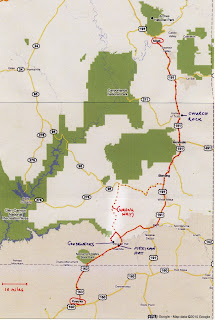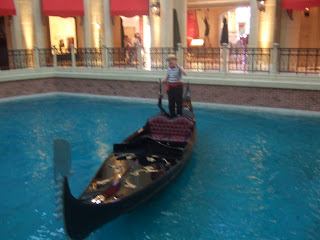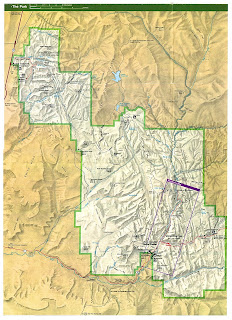Description of location: Grand Canyon; Arizona, Tusayan Ruins; GC, Arizona and Moenave Dinosaur tracks; just before Tuba City, Navajo.
Aspects of geography going to talk about: Tourism, Resource Management and Physical Geography.
Map showing the Grand Canyon; Arizona and the Navajo Indian Reservation

TourismThere are many forms of tourism; the ones that will be discussed are sustainable tourism, economic tourism, educational and adventure tourism experienced during the day.
On day two at the Grand Canyon some of us woke early to watch the sun rise at Yavapai view point. This view point gives tourists the opportunity to watch the Grand Canyon go from darkness to light with amazing light rays and shadow during the rise. This point is in a great place for this to happen. Information about the daily sunrise times are located in the visitor centre and leaflets given on arrival to allow tourists the option of doing this. After this we went on to do the Bright Angel trail.

The Tusayan ruins came next on the day’s activities; these could be seen by walking along a path past the Gathering Loop, storage area and living quarters. At both the Grand Canyon and the Tusayan ruins there were sufficient car parking areas and restroom available and accessible for all.
Finally we visited some dinosaur tracks in Navajo on the way to our motel in Kayenta. These were not as formal a places as we had been travelling around, however they were interesting and the people there seemed to know how to market there rare tourist experience.
Adventure TourismGrand Canyon - involved walked the Bright Angel Trail. This is the most popular trail into the canyon. It is a gentle walk offering plenty of shade. These factors enable the trail to be accessible for the majority of tourists which is possibly why it is so popular. The trail starts west of Bright Angel Lodge. Like the other walks the first Rest house on the trail is 1 and a half miles down. If you were an adventure seeking tourist then you could hike to the 4500ft to the bottom of this trek ending in Plateau point (12.2miles). However even for the most thrills seeking tourist it is unadvisable to walk up and down the canyon in one day. We on the other hand only walked a very little bit as were all hiked out after the Kaibob trail the day before.
The elevation of the Bright Angel starts at 6900ft so tourists with chest of breathing difficulties should take it slow and everyone needs to keep hydrated. If this was thought to be a problem then there is the option of going on the trail on a mule. We didn’t participate in this, however whilst we were walking down the trail a group of mules were returning to the top.

Educational TourismGrand Canyon - this involved us finishing off the Junior Ranger program. This is designed to keen children engaged and attempts to get them interested in geography and geology. This also includes generally looking at information boards and leaflets on the trail.
Tusayan Ruins – this was in the form of information boards around the path area displaying what everything was and how it was used 800 years ago when the Tusayan’s were inhabiting the area. For example, there was a big sage bush which uses included boiling the leaves to make dye and using the bark to weave baskets. Educational tourism also was apparent in the museum displaying artefacts and with guided tours.
Dinosaur tracks – no signs or information boards here, however the people who run this small business seem to know there stuff. Although the dinosaur footprints were real they do exaggerate what they have on offer by creating a story around them to enhance the tourist experience. For example they told us the prints were from common dinosaurs and they had planted eggs and bones to keep the illusion going.
Sustainable tourism
Grand Canyon - To make what we did more sustainable environmental wise the park could limit the numbers of people that trek this at a given time and over the course of the day as it did get quite busy which for some people spoilt the experience slightly. Litter bins are not provided on the path, however there are plenty at the rim and judging by the cleanliness of the area tourists are making use of the bins and not ruining this wonderful landscape.
Tusayan ruins – this area was sustainable as you couldn’t walk on the actual ruins but around a path, therefore preserving the area for generations to come. There were also litter bins and ashtrays at the entrance encouraging tourists to be kind to the environment. In the museum and at the entrance there were also signs to encourage ecotourism. The place was very clean so this is obviously working. Some areas were cornered off while we were there as revegetation work was occurring.
Dinosaur tracks – these were not very environmentally sustainable as we were as tourists allowed to walk over them, however this is probably the only way they could do the tour at all as they don’t have finances or backing to manage it any other way.

Economic tourism
Grand Canyon – this here included paying for the hotel, which incidentally was the most expensive hotel of the whole trip. So long as this money goes to the upkeep of the National Park that’s ok. This also included for us paying to enter the National Park, food shopping, eating ice cream, shopping in the tourist designed shops for souvenirs and for some paying $15 to the area for phone cards that don’t work……but hey maybe they’ll buy an air freshener for the toilet at Ceder ridge with that money! (There’s always hope)
Dinosaur tracks – this isn’t marketed as economic tourism as there is no fee to see them, however it is courteous to buy some of there jewellery or leave a donation. We decided to buy bracelets that were $8 each for 2 for $10. however if they were to charge at least the money would go directly to them as apposed to be eaten up by finances if they were taken over by a National Park or Government organisation.
Overall, the tourism varied from place to place with not every place offering the same types of tourism. The Grand Canyon offers more adventure tourism, and the ruins and dinosaur tracks almost being historic tourism. All sites provided educational aspects and need tourism to survive!
Resource Management
How do you preserve something so delicate and beautiful so that we, the current generation can enjoy it, as well as future generations?
In America, the Department of the Interior (DOI) is dominantly responsible for the management and preservations of resources, especially those associated with the use of public land. The Grand Canyon is a national state park, where as the Navajo Nation which we drove through, and Moenave Dinosaur Tracks are not designated public lands.
The Grand CanyonWithin the National Park of the Grand Canyon, resource management is taking very seriously. There is a highly recognised ranger programme (including junior ranger which we all got the badge for yeas!) In the desert of the SW USA, resources can be hard to retain, such as water. The Grand Canyon stores water, the amount for three days usage, in case the springs do not supply water is kept as a reserve. With out water many of the facilities would not be able to function, then causing a strain on other resources, such as food and restrooms. (Not all restrooms have running water though!) Environmental areas of re-vegetation had also been established to allow species of plants to be undisturbed by animals as well as humans.
Tusayan Ruin’s are managed with in the Grand Canyon, leading to a ranger being present at the site, and educating through talks and visits amidst the ruins. The resources are managed as the same to the rest of the park, and are also being developed with the increasing numbers of tourists.
Picture of Grand Canyon!
The carrying concept of the canyon (O’Reilly, 1986), looks at the amount of people in which an area can uphold. At the Grand Canyon, the capacity is always being reviewed, with constant development of facilities, thus developing the management of resources and how to keep the park running.
Moenave Dinosaur Footprints
Navajo Nation displayed a very different resource management in the attractions that were on offer. At the dinosaur footprints, the actual foot prints were not protected from the human interference (as mentioned above), leading to a poor management of land. The resources available at this location were also limited, no rest rooms or water were available, although jewellery was driven to the site to be sold.
Picture of Navajo Nation!!
Physical Geography
In context to the Grand Canyon and Navajo Nation, the physical geography is plentiful and able to be seen everywhere you look from geology to cloud formations.
Geology of the Grand Canyon
The geology of the Grand Canyon is one of intense diversity with rocks on display that date back over 2 billion years yet carved by wind and water over a period of only 5 million years. The rock strata on display shows many different periods of geological time and show constant periods of dryness and periods when the whole are was a shallow sea. One the day the group could only get down to the first two layers of the many that are present and they are the Kaibab limestone and the Toroweap formation. The Kaibab limestone’s where laid down when the area was covered by a shallow sea and the sand and sediments at the bottom where compressed until they turned into sedimentary rocks. This is evident by the presence of small marine animals that are present as fossils in the rock layer and also the presence of marine sands that the fossils are buried in. The stone is very crumbly and turns to sand very easily when broken down by wind or water and this makes it very easy to erode which happens on a regular basis. There are also large amounts of sandstone mixed in with the limestone and this also shows that there were coastal processes in evidence as the sand would of have to come from the coast as well as the sediments from the bottom of the seas. The second observed sediments was the Toroweap formation which is similar to the Kaibab as the sediments are similar but the Toroweap shows evidence of more sands than the Kaibab and this was probably dune sand coming in from onshore and being deposited at the mouth of a larger river of in the basin of a shallow sea. These two layers are concurrent with the known history of the area as that area of America was underwater during the Permian era when they were laid down but the seas where retreating which is shown in the rocks by the presence of more and more sand as the layers progress.
Picture of layers!!!!
Navajo Nation
The rocks in the Navajo nation are very similar to those at the Grand Canyon but with one important difference and this is the presence of dinosaur fossils. Theses where laid down in the early Jurassic when the area was many braided rivers flowing into the sea about where the Rockies are today. Theses river sediments allowed for very good impressions of footprints when a variety of dinosaurs walked across them and these where then covered by more sediments. Millions of years later they have been exposed by a combination of erosion factors both wind and water based and they have now been exposed to the wonderment (and scepticism) of many generations of university students!
Personal reflections on day
Very good day, watching sunrise and the sunset was awesome over the Canyon. The trail was a nice relax after the day before on the Kaibob. The Tusayan ruins were a good example of how America’s history has only just started to be preserved. Finally the dinosaur tracks were interesting as it brings a normally hard concept to comprehend (the fact dinosaurs existed) to life as there is clear evidence. The contrast between a national park and the Navajo nation was rather distinctive.
From reflecting on the day through this blog, it is evident that all three of the field trip themes are both clear and also inter-link with each other.
p.s. were all safe and having a wiked time :D
much love, andrew, cat and mary-anne

 The most prominent statigraphical layer in Monument Valley is 260 million year old Permian De Chelley Sandstone, which form the steep red cliffs that are iconic of this landscape. The buttes and mesas exist due to the hard cap rocks that cover their tops. These prevent erosion of the softer Moenkopi mudstone, Kaibab Limestone (the two thin layers above the De Chelley) and the sloping Organ Rock Shale beneath it. Desert climates in the region throughout the Quaternary have helped accentuate the bare rock landforms.
The most prominent statigraphical layer in Monument Valley is 260 million year old Permian De Chelley Sandstone, which form the steep red cliffs that are iconic of this landscape. The buttes and mesas exist due to the hard cap rocks that cover their tops. These prevent erosion of the softer Moenkopi mudstone, Kaibab Limestone (the two thin layers above the De Chelley) and the sloping Organ Rock Shale beneath it. Desert climates in the region throughout the Quaternary have helped accentuate the bare rock landforms.































 OMG! You are not gonna believe what just happened, here we are blogging away when the laptop froze. It’s all your fault, we tried to get a map from Google for you when it froze, so forget it, there will be no map. We even had to wake up Greg (pink pyjamas on Greg is not pretty!)
OMG! You are not gonna believe what just happened, here we are blogging away when the laptop froze. It’s all your fault, we tried to get a map from Google for you when it froze, so forget it, there will be no map. We even had to wake up Greg (pink pyjamas on Greg is not pretty!)



